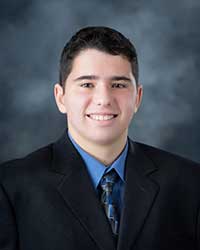It was in October of Jordan’s 5th grade year that he began having seizures.
As Jordan’s father, Michael, says, “At that time, we didn’t know what it was at all. It wasn’t the convulsing type of seizures. He would just go into a rocking position and make a clicking noise with his tongue. And he would be able to tell you when they’re getting ready to happen.”
A month went by and the seizures continued. The Blake family was becoming increasingly worried about the frequency of the seizures. On Thanksgiving Day 2014, they brought him to a hospital near the family’s home in West Virginia.
They spent about five or six hours in the Emergency Room that day. That hospital then transferred him to another hospital about 45 minutes away in Morgantown. At that point, Jordan was having 300 seizures in the span of about two or three days.
Doctors at the hospital in Morgantown diagnosed Jordan with epilepsy. They started him on an anti-epilepsy drug (AED) regimen to attempt to control his seizures.
“The medicine helped a little bit,” says Michael. “We ended up trying about 15 different medicines. They would work for a while and then they wouldn’t. Some of the medicine he was on would make him like a zombie. He would sleep 20 hours a day.”
Under this medication only treatment plan, Jordan’s quality of life suffered. The different medications affected Jordan's concentration and his grades began to plummet. He also couldn’t go outside and play or do other activities because the medication would not allow him to sweat.
Feeling like this was the only way to help Jordan, the family pursued this route for about six or seven years. They felt frustrated and hopeless.
“You know, I’ve been in Fire/EMS for close to 40 years. I can handle blood, broken bones,” said Michael. “But when he would be having a seizure, I would just hold him and I didn’t know what to do. It’s one of the hardest things, seeing your child suffering and not being able, as a parent, to help him.”
Seeking a Second Opinion in Pittsburgh
Around 2020, a family member of the Blakes suggested they go to Pittsburgh for another opinion on Jordan’s case. They were willing to try anything to improve Jordan’s quality of life. So they scheduled an appointment with the Epilepsy Center at UPMC Children’s Hospital of Pittsburgh’s Brain Care Institute. The Center is a Level 4 accredited center, providing the highest level of treatment for children with epilepsy.
“It’s something I we wish we would have done years before,” says Michael.
In February 2021, the Blakes met with Luis Fernandez, MD, an epileptologist and neurologist at Children’s. Dr. Fernandez diagnosed Jordan with cortical dysplasia, a congenital brain anomaly that is present at birth.
Before children are born, developing brain cells organize into layers to form the cerebral cortex, the outermost part of the brain. In some children, the brain cells fail to organize in the way they're genetically supposed to. When this happens, the cerebral cortex does not form properly and can result in cortical dysplasia.
“As Dr. Fernandez explained [cortical dysplasia] to us, he used the example that most people’s brain cells are organized ‘1,2,3,4,5,6,7,' etcetera whereas with Jordan, his are organized '4,2,5,1,6,3,7.' That made a lot of sense to us.”
Cortical dysplasia is one of the most common causes of epilepsy and seizures. For most children with cortical dysplasia, seizures are difficult to control with medication. Because of this, and taking into account Jordan’s specific history and symptoms, Dr. Fernandez recommended surgery.
Life Changing Surgery
The doctors explained the associated risks of the surgery to the Blake family to consider. Because epilepsy can vary significantly from patient to patient, no patient will necessarily have the same experience as another patient, even with the same treatment.
“We thought about the surgery a lot,” said Michael. “And we prayed a lot about it. There was prayer everywhere going on. We were talking with Jordan about it, explaining that there could be complications. And he looked at us and said, ‘Dad, I would just like to have a normal life.’ And at that point, I knew we would do the surgery. I told him that whatever it takes, we’re going to do that for you.”

In October 2021, eight months after his initial meeting with Dr. Fernandez, Jordan underwent a minimally invasive eyebrow craniotomy. Taylor Abel, MD, pediatric neurosurgeon and surgical director of the Pediatric Epilepsy Program at Children’s, performed the surgery. Pediatric plastic surgeon Tonya Stefko, MD, assisted Dr. Abel to ensure there wouldn’t be much of a scar left behind. The surgery was successful, and the Blakes are happy to report that Jordan has been seizure-free ever since.
A Seizure-Free Future for Jordan
When asked about their experience at Children’s, Michael had only one word to offer: “Amazing.”
“The nurses treated Jordan like their own child. It’s hard to explain. Anything he needed; they would help.”
Jordan returned home to West Virginia the day after his surgery. He stayed home from school for several weeks to recover. Since then, his quality of life has improved tremendously. He still has some headaches and a small scar from the procedure, but now he can live a more fulfilled, seizure-free life.
Today, Jordan is finishing his senior year of high school. After high school, his plans involve working with a different kind of electrical impulses as a lineman for a power company.
And Michael’s advice to any parents who find themselves in a similar situation to theirs is this:
“Definitely get two opinions. That is something I wish we would have done sooner. Study [epilepsy]. And don’t punish your kids [for their behavior when dealing with epilepsy]; it’s not their fault. Jordan kept saying, ‘Dad, I’m broken.’ And I would insist, ‘You’re not broken, you’re just special. And we’ll do whatever it takes.”









